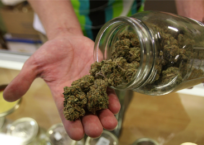
Associated Press
WASHINGTON —The U.S. Department of Health and Human Services has delivered a recommendation to the Drug Enforcement Administration on marijuana policy, and Senate leaders hailed it Wednesday as a first step toward easing federal restrictions on the drug.
U.S. Senate Majority Leader Chuck Schumer (D-NY) said in a statement that HHS had recommended marijuana be moved from a Schedule I to a Schedule III controlled substance.
“HHS has done the right thing,” Schumer said. Rescheduling the drug would reduce or potentially eliminate criminal penalties for possession. Marijuana is currently classified as a Schedule I drug, alongside heroin and LSD.
###
Cannabis Use Disorder (CUD) is a real thing and is increasing as more states legalize. Findings in a recent study printed at JAMA Network found out of 1,463 patients who reported using cannabis for medical and nonmedical reasons, CUD was prevalent 21.3 percent. “Moderate to severe CUD was more prevalent among patients who reported any nonmedical use.” At least 2 out of 11 symptoms must manifest to be diagnosed with CUD.
“Scromiting” which consists of screaming and vomiting, or Cannabinoid hyperemesis syndrome as its known in the medical field, may also be on the rise due to the increase in legalization.
The Rocky Mountain High Intensity Drug Trafficking Area has tracked and analyzed the consequences of marijuana legalization for years. Their findings are not disputed, yet states have ignored the data. The most recent report states:
- Colorado traffic fatalities where the driver tested positive for marijuana increased 138% since legalization (2013) while other traffic deaths increased 29 percent.
- Past month marijuana use for ages 12 and older increased 26 percent and is 61 percent higher than the national average, currently ranked 3rd in the nation.
- Marijuana is the most prevalent substance found in completed suicides of children and young adults ages 10 to 19.
- Calls to the poison control center for children ages 0-18 went from 18 in 2009 (commercialization) to 65 in 2013 (legalization) to 245 in 2020.
There have been other attempts to ease restrictions or “reschedule” marijuana. The Controlled Substances Act was passed into federal law in 1970. It classifies drugs into five schedules based on their safety, potential for abuse, and medical use. Marijuana has always been a Schedule 1 drug. This means:
- The drug or other substance has a high potential for abuse.
- The drug or other substance has no currently accepted medical treatment use in the U.S.
- It has a lack of accepted safety for use under medical supervision.
In 1972, the National Commission on Marijuana and Drug Abuse recommended it be decriminalized. It was not implemented.
In 1978, the Drug Enforcement Administration began the process to reschedule it to Schedule II or III. The process was halted in 1986 when the DEA’s chief administrative law judge ruled that marijuana should be reclassified as Schedule II1. However, the DEA administrator overruled the judge’s ruling and kept marijuana in Schedule I.
In 2002, the Coalition for Rescheduling Cannabis filed a petition with the DEA to reschedule marijuana to Schedule III or IV. It was denied in 2011 and the decision was upheld by a federal appeals court in 2013.
Rescheduling marijuana is the first step to federal legalization and is a very foolish endeavor led by people who profit from it and have little to no regard for the harm it brings to families.





















